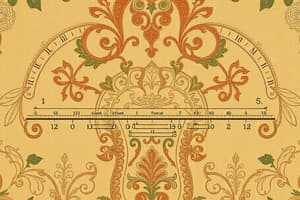Podcast
Questions and Answers
Which scale of measurement involves categories that are mutually exclusive and collectively exhaustive?
Which scale of measurement involves categories that are mutually exclusive and collectively exhaustive?
- Ordinal Scale
- Ratio Scale
- Interval Scale
- Nominal Scale (correct)
Ordinal scales provide information about the order of categories.
Ordinal scales provide information about the order of categories.
True (A)
What characteristic does an interval scale incorporate that nominal and ordinal scales do not?
What characteristic does an interval scale incorporate that nominal and ordinal scales do not?
Equality of interval
Ratio scales have the provision for __________.
Ratio scales have the provision for __________.
Which of the following is NOT a characteristic of nominal scales?
Which of the following is NOT a characteristic of nominal scales?
Ordinal scales allow for statements such as 'greater than' or 'less than'.
Ordinal scales allow for statements such as 'greater than' or 'less than'.
Name one potential error source that can distort measurement.
Name one potential error source that can distort measurement.
Match the following measurement scales with their descriptions:
Match the following measurement scales with their descriptions:
What is the primary goal of measurement in research?
What is the primary goal of measurement in research?
Measurement consists solely of assigning numbers to physical objects.
Measurement consists solely of assigning numbers to physical objects.
Name one major source of measurement error.
Name one major source of measurement error.
The three tasks of measurement include selecting variables to measure, developing a set of mapping rules, and _____ to each observation.
The three tasks of measurement include selecting variables to measure, developing a set of mapping rules, and _____ to each observation.
Which of the following is an example of an object measured in research?
Which of the following is an example of an object measured in research?
Match the types of measurement scales with their descriptions:
Match the types of measurement scales with their descriptions:
Which of the following is NOT one of the major criteria for evaluating a measurement tool?
Which of the following is NOT one of the major criteria for evaluating a measurement tool?
Constructs are more tangible than concepts.
Constructs are more tangible than concepts.
Content validity ensures that a measurement tool adequately covers the investigative questions of a study.
Content validity ensures that a measurement tool adequately covers the investigative questions of a study.
What is meant by 'properties' in the context of measurement?
What is meant by 'properties' in the context of measurement?
What are the four qualities that a criterion measure must be judged on?
What are the four qualities that a criterion measure must be judged on?
___ validity reflects the success of measures used for prediction or estimation.
___ validity reflects the success of measures used for prediction or estimation.
Match the following types of validity with their definitions:
Match the following types of validity with their definitions:
Which form of reliability is concerned with consistent results from repeated measurements?
Which form of reliability is concerned with consistent results from repeated measurements?
A relevant criterion is defined and scored in a way that is unrelated to the measurement goals.
A relevant criterion is defined and scored in a way that is unrelated to the measurement goals.
What does practicality in measurement refer to?
What does practicality in measurement refer to?
What is measured by the stability of an observation procedure?
What is measured by the stability of an observation procedure?
Equivalence in reliability focuses on the stability of measurements over time.
Equivalence in reliability focuses on the stability of measurements over time.
What is internal consistency concerned with?
What is internal consistency concerned with?
A measurement instrument is considered practical if it has _____, convenience, and interpretability.
A measurement instrument is considered practical if it has _____, convenience, and interpretability.
Match the aspect of reliability with its description:
Match the aspect of reliability with its description:
Which technique can be used to assess internal consistency?
Which technique can be used to assess internal consistency?
Convenience in a measurement instrument refers to its interpretability.
Convenience in a measurement instrument refers to its interpretability.
What does the economy aspect in practicality refer to?
What does the economy aspect in practicality refer to?
Flashcards are hidden until you start studying
Study Notes
Measurement
- The goal of measurement in research is to provide the highest-quality, lowest-error data for testing hypotheses, forming estimates or predictions, or describing.
- Tasks of measurement:
- Select variables to measure.
- Develop a set of mapping rules for assigning numbers or symbols to represent aspects of the variable being measured.
- Apply the mapping rules to each observation of that event.
- What is Measured? Variables measured in research can be classified as objects (concepts or constructs) or properties which are characteristics of an object.
- Concepts are concrete and tangible items of daily life (e.g., furniture, laundry detergent).
- Constructs are more abstract (e.g., peer pressure, leadership, lifestyle).
Measurement Scales
- Nominal Scales: Used to classify, group, or sort responses. No order exists because the numbers have no arithmetic value.
- Ordinal Scales: Include the characteristics of the nominal scale plus an indication of order. This implies a statement of "greater than" or "less than" or "equal to".
- Interval Scales: Have the power of nominal and ordinal data plus the concept of equality of interval. Calendar time is an example.
- Ratio Scales: Incorporate all the powers of the previous scales plus the provision for absolute zero.
Sources of Measurement Error
- Participant Situational Factors: Any condition that places a strain on the interview or measurement session can affect responses (e.g., interviewer-participant rapport).
- Measurer: Rewording, paraphrasing, or reordering questions can distort responses.
- The Instrument: A defective measurement instrument can cause distortion. Ambiguity or failure to cover necessary questions are examples of instrument deficiency.
Characteristics of Good Measurement
- Validity: The extent to which a chosen or developed scale actually measures what it's intended to measure.
- Content Validity: The extent to which a measuring instrument provides adequate coverage of the investigative questions guiding the study.
- Criterion-Related Validity: Reflects the success of measures used for prediction or estimation.
- Construct Validity: Considers both the theory and the measurement instrument being used.
- Reliability: The accuracy and precision of a measurement procedure. A measure is reliable to the degree that it supplies consistent results.
- Stability: Consistent results with repeated measurements of the same person with the same instrument.
- Equivalence: Considers how much error may be introduced by different investigators or measurement questions.
- Internal Consistency: Assesses the homogeneity among the items or measurement questions.
- Practicality: Concerns economic, convenience, and interpretability factors.
- Economy: Trade-off between the ideal research project and budget.
- Convenience: Ease of administration.
- Interpretability: Ease of interpreting the results.
Studying That Suits You
Use AI to generate personalized quizzes and flashcards to suit your learning preferences.




